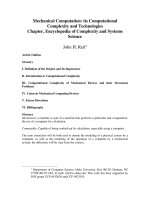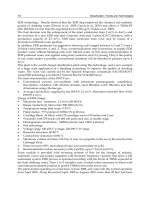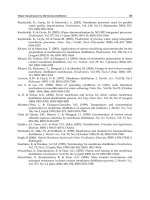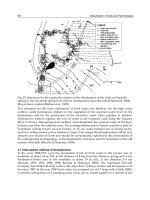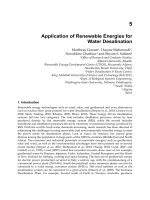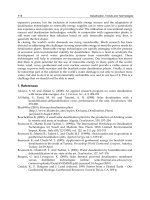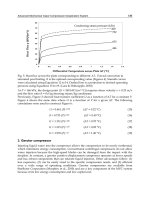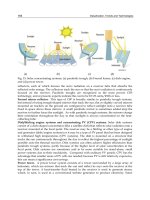Manufacturing and automation systems techniques and technologies part 1 of 5 three pillars of manufacturing technology ( TQL)
Bạn đang xem bản rút gọn của tài liệu. Xem và tải ngay bản đầy đủ của tài liệu tại đây (4.81 MB, 357 trang )
CONTRIBUTORS TO THIS VOLUME
JAMES S. ALBUS
DONALD S. BLOMQUIST
HOWARD P. BLOOM
GARY P. CARVER
RICHARD H. F. JACKSON
ALBERTJONES
PHILIP Ν ANZETTA
JOHN A. SIMPSON
DENNIS A. SWYT
CONTROL AND
DYNAMIC SYSTEMS
ADVANCES IN THEORY
A N D APPLICATIONS
Volume Editor
Edited by
RICHARD H. F. JACKSON
C. T. LEONDES
Manufacturing Engineering Laboratory
National Institute of Standards & Technology
Gaithersburg, Maryland
School of Engineering and Applied Science
University of California, Los Angeles
Los Angeles, California
and
College of Engineering
University of Washington
Seattle, Washington
V O L U M E 4 5 : MANUFACTURING AND
AUTOMATION SYSTEMS:
TECHNIQUES AND TECHNOLOGIES
Part 1 of 5
Three Pillars of Manufacturing Technology
ACADEMIC PRESS, INC.
Harcourt Brace Jovanovich, Publishers
San Diego New York Boston
London
Sydney Tokyo Toronto
ACADEMIC PRESS RAPID MANUSCRIPT REPRODUCTION
The articles in this work are
U.S. government works in the
public domain.
This book is printed on acid-free paper. @
Copyright © 1992 by ACADEMIC PRESS, INC.
All Rights Reserved.
No part of this publication may be reproduced or transmitted in any form or by any
means, electronic or mechanical, including photocopy, recording, or any information
storage and retrieval system, without permission in writing from the publisher.
Academic Press, Inc.
1250 Sixth Avenue, San Diego, California 92101
United Kingdom Edition published
by
Academic Press Limited
24-28 Oval Road, London NW1 7DX
Library of Congress Catalog Number: 64-8027
International Standard Book Number: 0-12-012745-8
PRINTED IN THE UNITED STATES OF AMERICA
92
93
94
95
96
97
BC
9
8 7
6
5
4
3
2 1
CONTRIBUTORS
Numbers in parentheses indicate the pages on which the authors* contributions begin.
James S. Albus (197), Robot Systems Division, Manufacturing Engineering Laboratory, National Institute of Standards and Technology, Gaithersburg, Maryland
20899
Donald S. Blomquist (163), Automated Production Technology Division, Manufacturing Engineering Laboratory, National Institute of Standards and Technology,
Gaithersburg, Maryland 20899
Howard P. Bloom (31), Factory Automation Systems Division, Manufacturing Engineering Laboratory, National Institute of Standards and Technology,
Gaithersburg, Maryland 20899
Gary P. Carver (31), Factory Automation Systems Division, Manufacturing Engineering Laboratory, National Institute of Standards and Technology,
Gaithersburg, Maryland 20899
Richard H. F. Jackson (1), Manufacturing Engineering Laboratory, National Institute of Standards and Technology, Gaithersburg, Maryland 20899
Albert Jones (249), Manufacturing Engineering Laboratory, National Institute of
Standards and Technology, Gaithersburg, Maryland 20899
Philip Nanzetta (307), Office of Manufacturing Programs, Manufacturing Engineering Laboratory, National Institute of Standards and Technology, Gaithersburg,
Maryland 20899
John A. Simpson (17,333), Manufacturing Engineering Laboratory, National Institute of Standards and Technology, Gaithersburg, Maryland 20809
Dennis A. Swyt (111), Precision Engineering Division, National Institute of Standards and Technology, Gaithersburg, Maryland 20899
vii
PREFACE
At the start of this century, national economies on the international scene were,
to a large extent, agriculturally based. This was, perhaps, the dominant reason
for the protraction, on the international scene, of the Great Depression, which
began with the Wall Street stock market crash of October 1929. In any event,
after World War II the trend away from agriculturally based economies and toward industrially based economies continued and strengthened. Indeed, today,
in the United States, approximately only 1% of the population is involved in the
agriculture industry. Yet, this small segment largely provides for the agriculture
requirements of the United States, and, in fact, provides significant agriculture
exports. This, of course, is made possible by the greatly improved techniques
and technologies utilized-in the agriculture industry.
The trend toward industrially based economies after World War II was, in
turn, followed by a trend toward service-based economies; and, in fact, in the
United States today roughly 70% of the employment is involved with service
industries, and this percentage continues to increase. Nevertheless, of course,
manufacturing retains its historic importance in the economy of the United States
and in other economies, and in the United States the manufacturing industries
account for the lion's share of exports and imports. Just as in the case of the
agriculture industries, more is continually expected from a constantly shrinking
percentage of the population. Also, just as in the case of the agriculture industries, this can only be possible through the utilization of constantly improving
techniques and technologies in the manufacturing industries in what is now popularly referred to as the second Industrial Revolution. As a result, this is a particularly appropriate time to treat the issue of manufacturing and automation systems in this international series. Thus, this is Part 1 of afive-partset of volumes
devoted to the most timely theme of "Manufacturing and Automation Systems:
Techniques and Technologies."
"Three Pillars of Manufacturing Technology" is the title of this volume. It is
edited by Richard H. F. Jackson, and its coauthors are Dr. Jackson and his colleagues at the National Institute of Standards and Technology (NIST) Manufacturing Engineering Laboratory, a unique organization on the international scene.
ix
χ
PREFACE
Ordinarily, in this Academic Press series, the series editor provides the overview
of the contents of the respective volumes in the Preface. However, in the case of
this unique volume, this, among other things, is provided by Dr. Jackson in the
first chapter of this volume. Therefore, suffice it to say here that Dr. Jackson and
his colleagues are all to be most highly commended for their efforts in producing
a most substantively important volume that will be of great and lasting significance on the international scene.
C. T. Leondes
ACKNOWLEDGMENT
There are many who contributed to the production of this book whose names
do not appear on title pages. Principal among these are Barbara Horner and Donna
Rusyniak, and their participation bears special mention. Their editorial and organizational skills were invaluable in this effort, and their untiring and cheerful
manner throughout made it all possible.
Richard H. F. Jackson
xi
MANUFACTURING TECHNOLOGY:
THE THREE PILLARS
RICHARD H.F. JACKSON
Manufacturing Engineering Laboratory
National Institute of Standards and Technology
Gaithersburg,MD 20899
I. INTRODUCTION
In their simplest form, the three pillars of manufacturing technology are: robots,
computers, and production equipment (or, in the case of mechanical
manufacturing: machine tools). Since the mid-twentieth century and the onslaught
of the second industrial revolution, these three pillars have formed the foundation
upon which all new techniques and advances in the technology of factory floor
systems have been built. This is of course not to deny the importance of advances
in non-technology areas such as lean production, quality management, continuous
improvement, and workforce training. On the contrary, improvements in these
areas can provide significant gains in industrial productivity and competitiveness.
Nevertheless, in the area of manufacturing systems the three pillars are just that:
the foundation. Because of their importance to the manufacturing systems of
today, and because they will also be critical to the development of the advanced
manufacturing systems of tomorrow, they are the theme of this volume. Further,
these pillars form the foundation of the advanced manufacturing research at the
Manufacturing Engineering Laboratory (MEL) of the National Institute of
Standards and Technology (NIST), and since that work is at the center of the U.S.
government's programs in advanced manufacturing research and development, it
CONTROL AND DYNAMIC SYSTEMS, VOL. 45
1
RICHARD H. F. JACKSON
2
is featured here . The chapters were produced by staff of MEL and can be
considered a profile of a successful research and development effort in
manufacturing technology, which profile is aimed at providing guidance for those
who would expand on it.
1
II. A VISION OF MANUFACTURING IN THE TWENTYFIRST CENTURY
To thrive in the twenty-first century, a manufacturing enterprise must be globally
competitive, produce the highest quality product, be a low cost, efficient producer,
and be responsive to the market and to the customer. In short, the next century's
successful manufacturing firms will be "World Class Manufacturers" who make
world class products for world class customers; i.e, customers who know precisely
what they want and are satisfied only with world-class products.
There are many perspectives from which one can view a world class
manufacturing firm. It can be viewed from the perspective of the shop floor and
its interplay of the hardware and software of production. It can be viewed from
the perspective of the legal environment in which it operates, both nationally and
internationally. It can be viewed from the standpoint of the business environment,
with its complex of tax and capital formation policies that affect long- and shortterm planning. It can be viewed from the perspective of its corporate structure
and embedded management techniques, which may facilitate or impede progress
toward a manufacturing system of the twenty-first century. It may be viewed
through the eyes of its employees, and the way it incorporates their ideas for
improving the manufacturing process, the way it seeks to train them and upgrade
their skills, and the way it strives to integrate them with the intelligent machines
of production. It may be viewed from the perspective of its policies for
performing, understanding, incorporating and transferring state-of-the-art
research in advanced manufacturing technology.
A world class manufacturer may be viewed from these and many other
perspectives, but, as depicted in Figure 1, the essential issue of importance for a
successful twenty-first century manufacturing enterprise is to learn how to operate
smoothly and efficiently within each of these regimes and to combine them into
a smoothly functioning, well-oiled engine of production. Such an engine takes as
input the classical categories of labor, capital, and material, and produces world
class products for world class customers.
*See the Appendix to this Introduction for a brief description of the
Manufacturing Engineering Laboratory and its programs.
M A N U F A C T U R I N G TECHNOLOGY: THE THREE PILLARS
3
21ST CENTURY MANUFACTURING
Figure 1. Twenty-First Century Manufacturing.
While each of these perspectives is certainly important in its own right, and the
interplay with the other factors is critical, in this book we concentrate on two of
the gears of the well-oiled machine: manufacturing technology research and
development, and technology deployment. We concentrate on these because
these are the only appropriate areas for a scientific and engineering laboratory
like NIST to address. In fact, NIST is the only federal research laboratory with
a specific mission to support U.S. industry by providing the measurements,
calibrations, quality assurance techniques, and generic technology required by U.S.
industry to support commerce and technological progress.
III. THE THREE PILLARS OF MANUFACTURING
TECHNOLOGY
We have organized this book and our programs at NIST around the three basic
components of any successful mechanical manufacturing system: machine tools
and basic precision metrology, intelligent machines and robotics, and computing
and information technology, all overlaid on a background of standards and
measurement technology, as shown in Figure 2. These are the three pillars of
manufacturing technology research and development because they have been,
are, and will be for some time to come, the quintessential components of factory
4
RICHARD H. F. JACKSON
floor systems from the very small to the very large. That is, in one fashion or
another they have been addressed on factory floors since the establishment of the
second manufacturing paradigm [1]. Further, in one fashion or another, they will
continue to be addressed by those who seek to refine this paradigm over the next
twenty tofiftyyears. Measurement is important because, simply put, if you cannot
measure, you cannot manufacture to specifications. Standards are important to
this foundation because, among other things, they help define the interfaces that
allow interconnections among the elements of manufacturing enterprises, and the
subsequent interchange of process and product information.
THREE PILLARS OF MANUFACTURING
TECHNOLOGY RESEARCH AND DEVELOPMENT
Machine Tools
Computers
111
STANDARDS AND MEASUREMENTS
Figure 2. Three Pillars of Manufacturing Technology R&D.
It is not the intent of this introductory chapter to dwell in detail on these three
pillars: that is accomplished in the remaining chapters. Nevertheless, it is
important to provide some additional detail here, so as to put in context those
remaining chapters. For example, in the area of computing and information
technology, a twenty-first century manufacturer can be depicted as shown in
Figure 3. This figure and the information technology aspects of it are discussed
fully in Chapter 3 of this book. The figure depicts the enormous amount of
information that will be available in such an enterprise, and the importance of
providing a smoothly functioning, seamless mechanism for making all the
information available to whomever needs it, whenever and wherever it may be
M A N U F A C T U R I N G TECHNOLOGY: THE THREE PILLARS
5
needed. These enterprises may be collocated as indicated on the left or they may
be distributed throughout the country, or indeed the world. In any case, these
information-laden enterprises must find ways to collect, store, visualize and access
the information that is required for process-monitoring and decision-making. The
exploded view at the right shows how one portion of such an enterprise would be
integrated through the sharing of process and product data. The development of
product data exchange standards is a critical component in the development of
such an integrated enterprise.
INFORMATION TECHNOLOGY
I ARCHITECTURE 245 DATA 245INFORMATION SYSTEMS 245 CONTO«. 245 INTERFACE 245 TESTING L
Figure 3. Information Technology in the Twenty-First Centuiy
Indeed, the thesis is put forth in Chapter 3 that the development of product
data exchange technology and international agreement on standards for the
exchange of such data form the last real opportunity for U.S. industry to catch up
to, and perhaps even leapfrog, the Japanese manufacturing juggernaut. Some in
this country believe that there is very little about Japanese manufacturing
techniques that we do not know. The challenge for us is to find a way to apply
those techniques within our distinctly U.S. culture of creativity and entrepreneurial
drive of the individual and the independent enterprise, and to apply it both in the
advancement of technology and in the conduct of business. Product data
exchange standards and the technologies like concurrent engineering and
enterprise integration that are subsequently enabled by them may just be the
6
RICHARD H. F. JACKSON
answer to this challenge. For example, students of manufacturing technology have
long held that one of the keystones of Japanese manufacturing success is the
"Keiretsu," a large, vertically integrated corporation with complete control of the
manufacturing process from raw material to distribution, achieved through stable
corporate structures and person-to-person interactions. Complete integration of
all aspects of a manufacturing enterprise from design to manufacturing to
marketing and sales, in a homogeneous, collocated or widely diverse and
distributed enterprise is, in a sense, an "electronic Keiretsu." Such electronic
Keiretsu could provide for U.S. manufacturers the "level playing field" required
to compete successfully against the vertically integrated traditional Keiretsu in
Japan. Product data exchange standards are the heart and soul of concurrent
engineering and enterprise integration, and are critical to the ability of U.S.
Manufacturers to survive into the next century. More on this and on the emerging
technologies of concurrent engineering and enterprise integration is given in
Chapter 3.
In the area of machine tools and basic metrology, the next pillar, impressive
gains have been made in recent years, and will continue to be made in the future.
The machine tools of the next century will exploit these gains and will be capable
of heretofore unheard-of precision, down to the nanometer level. These gains will
be possible through the combination of new techniques in machine tool quality
control and in our ability to see, understand, and measure at the atomic level.
After all, the truism that in order to build structures, one must be able to measure
those structures, applies at the atomic level also. Even today, there are U.S.
automobile engines manufactured with tolerances of 1.5 micrometers, pushing the
limits of current machine tool technology. Next generation machine tool
technology is depicted in Figure 4. It is noteworthy that both machine tools and
coordinate measuring machines will make gains in precision based on the same
kind of technologies, and thus it will be possible to have both functions available
in one collection of cast iron. The metrological aspects of achieving such precision
are further discussed in Chapter 4. The process control issues are discussed
further in Chapter 5.
Intelligent machines today and tomorrow go far beyond the simple industrial
robots and automated transporters of yesterday. These new machines are a finely
tuned combination of hardware components driven by a software controller with
enough built-in intelligence as to make it almost autonomous. These software
controllers will be capable of accumulating information from an array of advanced
sensors and probing devices, matching that information against their own worldmodel of the environment in which they operate, and computing optimum
strategies for accomplishing their tasks. These strategies must be determined in
real time and take into account the dynamic environment in which these machines
will operate. The sensory information obtained must of course conform to existing
standards of manufacturing data exchange. This can only be accomplished
M A N U F A C T U R I N G TECHNOLOGY: THE THREE PILLARS
7
M A N U F A C T U R I N G AMD M E A S U R I N G T O S U P E R - P R E C I S I O N
Figure 4. Machine Tools in the Twenty-First Century.
through a full understanding of the nature of intelligence and the development of
software tools and structures which facilitate their efficient implementation and
realization in a software controller. The architecture for such a controller is
illustrated in Figure 5, which indicates the hierarchical nature of the controller and
the processes for interaction with sensors and world models. NIST work in this
area, as well as in the development of a true theory of intelligence, is discussed in
Chapter 6 of this book.
The core of the NIST effort in advanced manufacturing is the Automated
Manufacturing Research Facility (AMRF), and no discussion of NIST work in
advanced manufacturing would be complete without some discussion of it. The
AMRF has played a significant role in the identification and development of new
and emerging technologies, measurement techniques, and standards in
manufacturing. In fact, it was a catalyst in the legislative process that resulted in
the Technology Competitiveness Act of 1988, which changed the name of the
National Bureau of Standards to NIST and enhanced our mission. Further, the
successful work described in the other chapters would not have been possible
without the development of this research facility. The AMRF is a unique
engineering laboratory. The facility provides a basic array of manufacturing
8
RICHARD H. F. JACKSON
Intelligent Machines and Processes
Intelligent C o n t r o l S y s t e m
A new generation of manufacturing:
goal driven behavior
sensory perception
world modeling
Ï s ^
shared control
user friendly
light weight
heavy loads
ultra precision
^7
guaranteed quality
programmable dynamics
Figure 5. Intelligent Machines in the Twenty-First Century.
equipment and systems, a "test bed," that researchers from NIST, industrial firms,
universities, and other government agencies use to experiment with new standards
and to study new methods of measurement and quality control for automated
factories. In this sense, it serves as kind of "melting pot" of ideas from researchers
across a broad spectrum of disciplines, talents, and skills. Credit should be given
here to the U.S. Navy's Manufacturing Technology Program for helping to support
the AMRF financially as well as in identifying fruitful opportunities for research.
The AMRF includes several types of modern automated machine tools, such
as numerically controlled milling machines and lathes, automated materialshandling equipment (to move parts, tools, and raw materials from one
"workstation" to another), and a variety of industrial robots to tend the machine
tools. The entire facility operates under computer control using an advanced
control approach, based on the ideas in Figure 5, and pioneered at NIST. The
architecture is discussed further in Chapter 6. The AMRF incorporates some of
the most advanced, most flexible automated manufacturing techniques in the
world. The key to a fully flexible, data-driven, automated manufacturing system
is the control system. Its architecture must be capable of integrating the separate
architectures of production management, information management, and
communications management. The evolution of some of these architectures is the
subject of chapter 7 of this book.
M A N U F A C T U R I N G TECHNOLOGY: THE THREE PILLARS
9
No amount of successful scientific or engineering research will have an effect
on our nation's competitiveness unless these ideas are successfully transferred to,
and deployed by, U.S. industry. It is NISTs mission to do so, and our history
shows extraordinary success in this area. Nevertheless, there is always room for
improvement, and the enhanced mission ascribed to NTST in 1988, includes some
valuable new programs in this outreach area. Chapter 8 of this book describes
some of the NIST work in this area of technology transfer and deployment, from
early times to more recent times.
Lastly, chapter 9 contains a more fully fleshed-out discussion of the twentyfirst century manufacturing system. It is based on observations of the history of
manufacturing, a recognition of the changing paradigms in this nationally critical
area, and a full understanding of the importance of the three pillars of
manufacturing technology research and development.
IV. HISTORICAL CONTEXT AND OUTLOOK
The United States is at a critical juncture in its manufacturing history. Since the
first industrial revolution, the U.S. manufacturing sector has maintained a position
of strength in competition for world market share. The strength of this industrial
base has provided incredible growth in the U.S. gross national product and
contributed immensely to the material well-being of the citizenry. Unfortunately,
this position and its beneficial effects on the standard of living can no longer be
taken for granted. U.S. industries are being threatened from all sides: market
share has been slipping, capital equipment is becoming outdated, and the basic
structure of the once mighty U.S. corporation is being questioned.
A growing national debate has focused on this decline of U.S. industry's
competitiveness and the resultant loss of market share in the global marketplace.
This rapid loss of competitiveness of American industry in international markets
is an extremely serious problem with wide-ranging consequences for the United
States' material well-being, political influence, and security. The national debate
on this subject has identified many possible culprits, ranging from trade deficits
to short-term, bottom-line thinking on the part of U.S. management.
Nevertheless, among them certainly are the slow rate at which new technology
is incorporated in commercial products and processes, and the lack of attention
paid to manufacturing. There is a clear need to compete in world markets with
high-value-added products, incorporating the latest innovations, manufactured in
short runs with flexible manufacturing methods. Research, management, and
manufacturing methods that support change and innovation are key ingredients
needed to enhance our nation's competitive position. In fact, efforts in these
areas seem to be paying off already. In his upbeat message on technology
opportunities for America [2], John Lyons, the NIST Director, reports impressive
gains recently in the cost of labor, productivity and the balance of trade.
As Lyons notes, one key area in which we must focus continued effort is in
commercializing new technologies. As a nation, we have been slow to capitalize
on new technology developed from America's own intellectual capability. Many
RICHARD H. F. JACKSON
10
ideas originating in the American scientific and technical community are being
commercially exploited in other parts of the world. In the past, small and midsized companies have led U.S. industry in innovation. The nation must now find
ways to help such companies meet the demands of global competition, when the
speed with which firms are able to translate innovations into quality commercial
products and processes is of utmost importance.
Success in this effort will only come from full cooperation among government,
industry, and academe. Theis was clearly stated by the President's Commission
on Industrial Competitiveness [3]:
"Government must take the lead in those areas where its resources and
responsibilities can be best applied. Our public leaders and policy must
encourage dialogue and consensus-building among leaders in industry,
labor, Government, and academia whose expertise and cooperation are
needed to improve our competitive position.... Universities, industry,
and Government must work together to improve both the quality and
quantity of manufacturing related education."
Many agendas have been written for how such cooperation should proceed and
what issues must be addressed by each of these sectors. (See, for example [416]). This book describes some efforts underway at NIST to aid U.S.
manufacturers in their own efforts to compete in the global marketplace, and
thrive in the next century. At the center of these efforts are the programs and
projects of the Manufacturing Engineering Laboratory at the National Institute
of Standards and Technology. Thus, the chapters focus on these programs and
projects.
The first chapter after this introduction provides some historical background
on the importance of measurement and standards in manufacturing. Following
that are four chapters discussed above that in essence are set pieces on NIST
work in the three pillars of manufacturing technology. These are followed by the
chapter on architecture development in our Automated Manufacturing Research
Facility, a chapter on our programs in technology transfer, and a closing chapter
on the future of manufacturing.
REFERENCES:
1.
J.A Simpson, "Mechanical Measurement and Manufacturing," in "Three
Pillars of Manufacturing Technology," R.H.F. Jackson, ed., Academic Press,
1991.
2.
J.W. Lyons, "America's Technology Opportunities," "The Bridge," National
Academy of Engineering, Vol. 21, No. 2, Summer 1991.
3.
Presidential Commission on Industrial Competitiveness, January 1985.
M A N U F A C T U R I N G TECHNOLOGY: THE THREE PILLARS
11
4.
"U.S. Technology Policy," Executive Office of the President, Office of
Science and Technology Policy, Washington, DC 20506, September 26,1990.
5.
"The Challenge to Manufacturing: A Proposal for a National Forum," Office
of Administration, Finance, and Public Awareness, National Academy of
Engineering, 2101 Constitution Avenue, NW, Washington, DC, 1988.
6.
"Making Things Better: Competing in Manufacturing," U.S. Congress, Office
of Technology Assessment, OTA-ITE-443, U.S. Government Printing Office,
Washington, DC 20402-9325, February 1990.
7.
"The Role of Manufacturing Technology in Trade Adjustment Strategies,"
Committee on Manufacturing Technology in Trade Adjustment Assistance,
Manufacturing Studies Board, National Research Council, National
Academy Press, 2101 Constitution Avenue, NW, Washington, DC 20418,
1986.
8.
"Toward a New Era in U.S. Manufacturing - The Need for a National
Vision," Manufacturing Studies Board, Commission on Engineering and
Technical Systems, National Research Council, National Academy Press,
2101 Constitution Avenue, NW, Washington, DC 20418, 1986.
9.
"Bolstering Defense Industrial Competitiveness - Preserving our Heritage
the Industrial Base Securing our Future," Report to the Secretary of Defense
by the Under Secretary of Defense (Acquisition), July 1988.
10.
"Paying the Bill: Manufacturing and America's Trade Deficit," U.S.
Congress, Office of Technology Assessment, OTA-ITE-390, U.S.
Government Printing Office, Washington, DC 20402, June 1988.
11.
M.R. Kelley and H. Brooks, "The State of Computerized Automation in U.S.
Manufacturing," Center for Business and Government, October 1988.
(Order from: Weil Hall, John F. Kennedy School of Government, Harvard
University, 79 John F. Kennedy Street, Cambridge, MA 02138.)
12.
"A Research Agenda for CIM, Information Technology," Panel on Technical
Barriers to Computer Integration of Manufacturing, Manufacturing Studies
Board and Cross-Disciplinary Engineering Research Committee jointly
Commission on Engineering and Technical Systems, National Research
Council, National Academy Press, 2101 Constitution Avenue, NW,
Washington, DC 20418, 1988.
13.
I.C. Magaziner and M. Patinkin, "The Silent War - Inside the Global
Business Battles Shaping America's Future," Random House, Inc., New
York, 1989.
12
RICHARD H. F. JACKSON
14.
C.J. Grayson, Jr. and C. O'Dell, "American Business - A Two-Minute
Warning - Ten changes managers must make to survive into the 21st
century," The Free Press, A Division of Macmillan, Inc., 866 Third Avenue,
New York, NY 10022,1988.
15.
S.S. Cohen and J. Zysman, "Manufacturing Matters - The Myth of the PostIndustrial Economy," Basic Books, Inc., New York, 1987.
16.
Μ. Κ Dertouzos, R.K. Lester, R.M. Solow, and the MIT Commission on
Industrial Productivity, "Made in America - Regaining the Productive Edge,"
The MIT Press, Cambridge, MA, 1989.
M A N U F A C T U R I N G TECHNOLOGY: THE THREE PILLARS
13
APPENDIX: THE MANUFACTURING
ENGINEERING LABORATORY
AT NIST
Since the Manufacturing Engineering Laboratory and its programs are featured
in this volume, we provide in this Appendix a brief discussion of the mission,
goals, and objectives of the Laboratory and its five Divisions.
The Manufacturing Engineering Laboratory (MEL) is one of eight technical
laboratories that comprise the National Institute of Standards and Technology.
Laboratory staff maintain competence in, and develop, technical data, findings,
and standards in manufacturing engineering, precision engineering, mechanical
metrology, mechanical engineering, automation and control technology, industrial
engineering, and robotics to support the mechanical manufacturing industries.
The laboratory develops measurement methods particularly suited to the
automated manufacturing environment as well as traditional mechanical
measurement services. The Laboratory also develops the technical basis for
interface standards between the various components of fully automated
mechanical manufacturing systems. The Laboratory consists of a staff of
approximately 300, with an annual budget of approximately $30 million, both of
which are devoted to the program goal, "to contribute to the technology base
which supports innovation and productivity enhancement in the mechanical
manufacturing industries on which the Nation's economic health depends."
The Laboratory is managed by the Director, the Deputy Director, the
Executive Officer, the Manager of the Office of Manufacturing Programs, the
Manager of the Office of Industrial Relations, and the Chiefs of the five Divisions:
the Precision Engineering Division, the Automated Production Technology
Division, the Robot Systems Division, the Factory Automation Systems Division,
and the Fabrication Technology Division. Each of these Division's programs, is
discussed in more detail below.
The Precision Engineering Division:
This five-group division develops and conveys metrological principles and
practices to support precision-engineered systems vital to U.S. manufacturing
industries. Its general work encompasses the physics and engineering of systems
which generate, measure and control to high resolution the length-dimensional
quantities of position, distance, displacement and extension. Specific work
focusses on: electron-, optical- and mechanical-probe microscopies; coordinate
measuring machines; and metrology-intensive production systems for automated
manufacturing, precision metal-working and integrated-circuit fabrication. Of
special concern are industries dealing with the fabrication of nanometer-scale
structures such as micro-machined mechanical components and lithographically
produced electronic devices. This is an emerging technology certain to be of
14
RICHARD H. F. JACKSON
major commercial significance, involving fierce international competition, and
requiring broad advances in metrology for its support.
The Robot Systems Division;
The Robot Systems Division is composed of five groups: the Intelligent Control
Group, the Sensory Intelligence Group, the Systems Integration Group, the
Unmanned Systems Group, and the Performance Measures Group. The goal of
the Robot Systems Division is to develop the technology base necessary to
characterize and measure the performance of, and establish standards for, future
generations of intelligent machines systems. To do so will require the extension
and fusion of the concepts of artificial intelligence and the techniques of modern
control to make control systems intelligent and make artificial intelligence systems
operate in real-time.
The control system architecture developed for the Automated Manufacturing
Research Facility (AMRF) at the National Institute of Standards and Technology
had its foundations in robotics research. The concepts of hierarchical control,
task decomposition, world modeling, sensory processing, state evaluation, and
real-time sensory-interactive, goal-directed behavior are all a part of this control
architecture. These concepts are derived from the neurosciences, computer
science, and control system engineering. The result of the AMRF project is a
generic modular intelligent control system with well defined interfaces. This
control architecture provides a first generation bridge between the high level
planning and reasoning concepts of artificial intelligence and the low level sensing
and control methods of servo mechanisms.
Industrial robots and computer controlled machine tools for manufacturing are
only the first of many potential applications of robotics. Future applications will
be in less structured, more unpredictable, and often more hostile environments.
The application of robotics and artificial intelligence to other sectors of industry,
commerce, space, and defense has the potential to vastly increase productivity,
improve quality, and reduce the cost of many different kinds of goods and
services.
The Robot Systems Division expects that the robotics technology currently
available or being developed (mostly with NASA and Department of Defense
funding) will be applied to produce a wide variety of intelligent machine systems.
The Division proposes to position itself to meet the measurement and standards
needs of this emerging industry by being actively involved in a variety of
developments so that it understands the underlying technology and discerns the
measurement and standards requirements.
The Robot Systems Division is currently working on applications of the AMRF
control system architecture to space telerobots for satellite servicing, to coal mine
automation, shipbuilding, construction, large scale (high payload, long reach)
robots, multiple cooperating semi-autonomous land vehicles (teleoperated and
supervised autonomy), and nuclear submarine operational automation systems.
M A N U F A C T U R I N G TECHNOLOGY: THE THREE PILLARS
15
The Factory Automation Systems Division;
The Factory Automation Systems Division develops and maintains expertise in
information technology and engineering systems for design and automated
manufacturing. This Division is composed of two offices and four groups: the
CALS/PDES Project Office, the IGES/PDES/STEP Office, the Product Data
Engineering Group, the Production Management Systems Group, the Integrated
Systems Group, and the Machine Intelligence Group. They provide leadership
in the development of national and international standards relating to information
technology for design and product data exchange to enhance the quality,
performance, and reliability of automated systems for manufacturing. In addition,
they perform research and develop the technology for integrated database
requirements to support product life cycles, requirements that can be reflected in
both standards for product data exchange and for information technology
frameworks needed to manage the data. They also perform research on
methodologies such as concurrent engineering as a means of promoting the
production of improved quality products for U.S. industry, and in information
technology in such areas as distributed database management, information
modeling, and computer networks. They develop validation, verification, and
testing procedures for emerging product data exchange standards and for the
performance of information technology systems for manufacturing, and perform
research in the information technology requirements for such manufacturing
processes as product design, process planning, equipment control, inspection, and
logistics support.
The Automated Production Technology Division:
The Automated Production Technology Division is composed of six Groups: the
Ultrasonic Standards Group, the Acoustic Measurements Group, the Sensor
Systems Group, the Sensor Integrations Group, the Mass Group, and the Force
Group. The Division develops and maintains competence in the integration of
machine tools and robots up to and including the manufacturing cell level. The
Division develops and maintains computer-assisted techniques for the generation
of computer codes necessary for the integration of machine tools and robots. The
Division also develops the interfaces and networks necessary to combine robots
and machine tools into workstations and workstations into manufacturing cells.
In addition, the Division performs the research and integration tests necessary for
in-process monitoring and gaging. The Staff maintains competence in engineering
measurements and sensors for static and dynamic force-related quantities and
other parameters required by the mechanical manufacturing industry. They also
conduct fundamental research on the nature of the measurement process and
sensory interaction, as well as the development, characterization, and calibration
of transducers used in discrete parts manufacturing.
16
RICHARD H. F. JACKSON
The Fabrication Technology Division:
This Division has three Groups: the Support Activities Group, the Special Shops
Group, and the Main Shops Group. The Fabrication Technology Division
designs, fabricates, repairs, and modifies precision apparatus, instrumentation,
components thereof, and specimens necessary to the experimental research and
development work of NIST. Services include: engineering design, scientific
instrument fabrication, numerically controlled machining, welding, sheet metal
fabrication, micro fabrication, grinding, optical fabrication, glassblowing, precision
digital measuring, tool crib, and metals storeroom. The Division also develops
and maintains competence in CAD/CAM, automated process planning, and shop
management systems.
MECHANICAL MEASUREMENT
AND MANUFACTURING
JOHN A. SIMPSON
Manufacturing Engineering Laboratory
National Institute of Standards and Technology
Gaithersburg, MD 20899
I. INTRODUCTION
The history of mechanical measurement and manufacturing are completely
intertwined. Each new development metrology gave rise to new manufacturing
procedures. Each new manufacturing development required new levels of
measurement precision and accuracy. In a broad outline, the history of the
interaction between measurement and manufacturing from the viewpoint of a
single manufacturer is detailed in the study by Ramchandran Jaikumar [1] of the
Beretta Arms Company.
Another viewpoint where this interplay is vividly displayed is in the modern
relationships between the development of modern manufacturing and the
programs of the National Bureau of Standards (NBS), predecessor of the
National Institute of Standards and Technology (NIST). The author has been
responsible for the NBS Dimensional Metrology Program since 1968, and for the
Program in Manufacturing Engineering since 1978.
II. THE BIRTH OF MANUFACTURING
Prior to approximately 1800, it is impossible to speak of the manufacturing of
mechanical parts. They were crafted, each one expressing the skill of the
mechanic that made them. There were few, if any, measurements. When
CONTROL AND DYNAMIC SYSTEMS, VOL. 45
17
18
JOHN A. SIMPSON
dimensions were needed, they were obtained by simple caliper comparison from
an original sample made by the master mechanic.
A. The English System
Manufacturing, in any real sense, began in England at the Woolwich Arsenal in
1789. Here, Henry Maudslay combined previous recent inventions made by
others, such as the lathe slide rest, the lead screw driven by change gears and by
1800 had produced the engine lathe for rotational parts, which remains virtually
unchanged today. The same technology was soon extended to milling machinery.
For the first time, it was possible to create precision measuring tools, such as
screw micrometers, and then use them to control the dimensional accuracy of
the parts being made. The process fed upon itself; each improvement in machine
permitted more precise instruments; each improvement in instruments lead to
better machines. Measurements to a precision of a few thousandths of an inch
were soon possible by craftsmen on the factory floor.
B. The Beginning of Drafting
Prior to 1800, Mechanical Drawings were unknown. The only, what we might
call, "manufacturing data structures" were physical models, one for each part and
a set for each craftsman. The second great manufacturing invention of the turn
of the 19th century occurred in France, when Gaspard Monge in 1801 published
La Geometrie Descriptive. This remarkable work not only defined the now
standard three-view, third-quadrant orthographic projection, but also for the first
time added dimensions to the drawing. He created a "manufacturing data
structure" infinitely reproducible, still ubiquitous today. Again, the use of
dimensions led to more measurements and the instruments to perform them.
With the machine tool and micrometer of Maudslay and the mechanical
drawing of Monge, an enabling technology of mechanical measurement and
manufacturing was complete. For the next one hundred andfiftyyears, it was to
form the enabling technology of the First Manufacturing Paradigm.
C. The American System
The next major step in the development of manufacturing and measurement
took place in the United States. In 1789, Eli Whitney was carrying out a contract
with the Army to produce muskets. He was using the pre-manufacturing
technology, with one significant difference. He was using jigs and fixtures to
allow the employment of less skilled labor, and in the process invented the "gono-go" gaging system. In its simplest form, this system to control the size of a
hole, for example, had a small plug which must "go" into the hole and a larger
plug which must not fit, "no-go," into the hole. Gaging has the advantage of being
much faster and easier than measurement but does not result in a number and
hence is of somewhat limited usefulness. Although now subject to controversy
